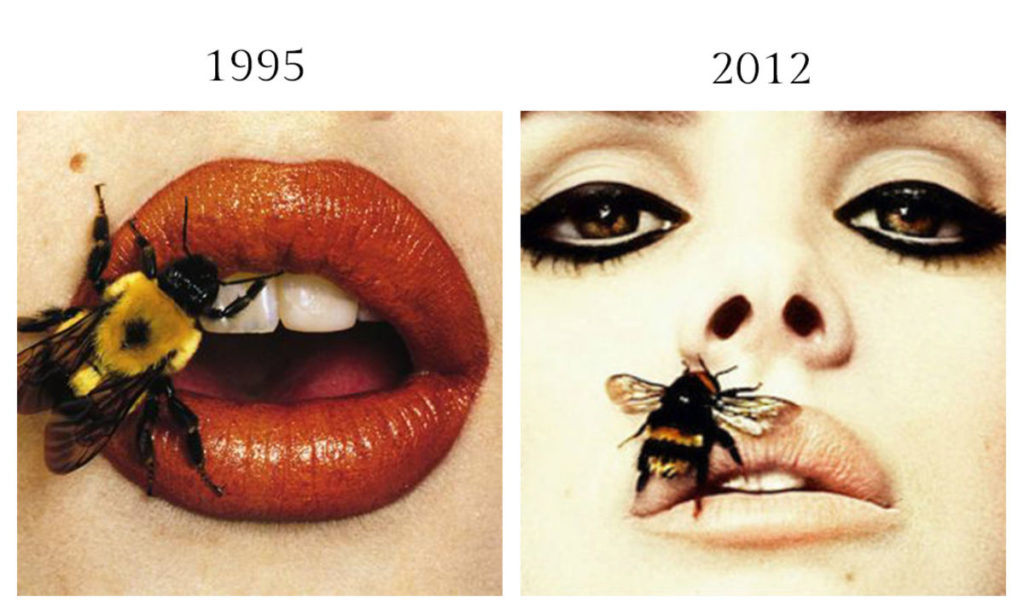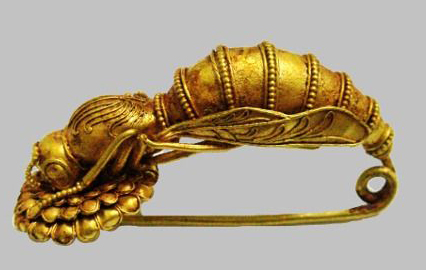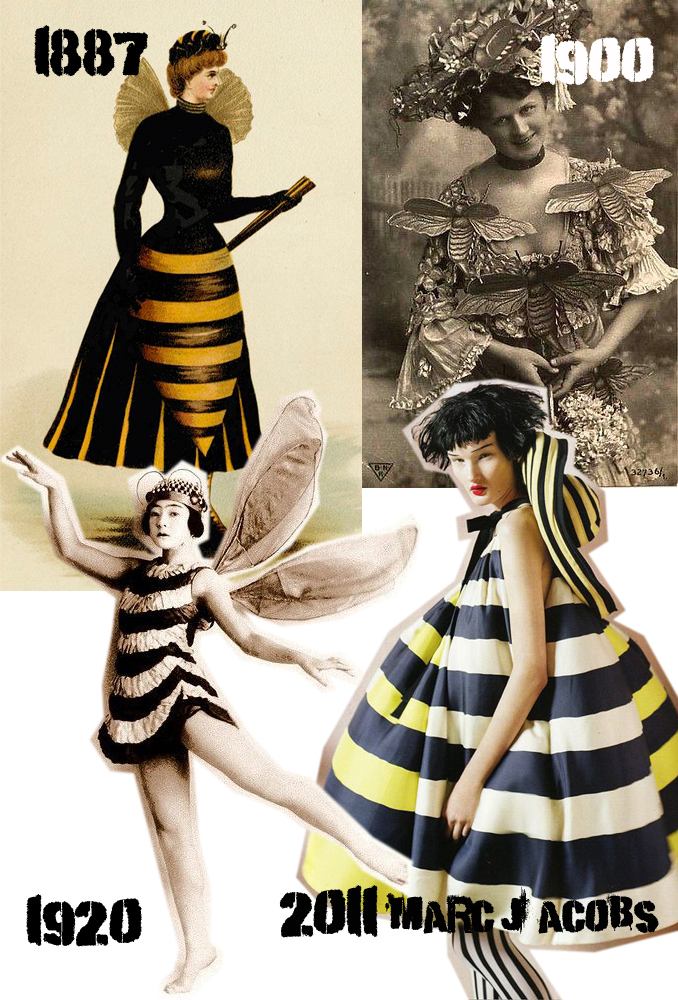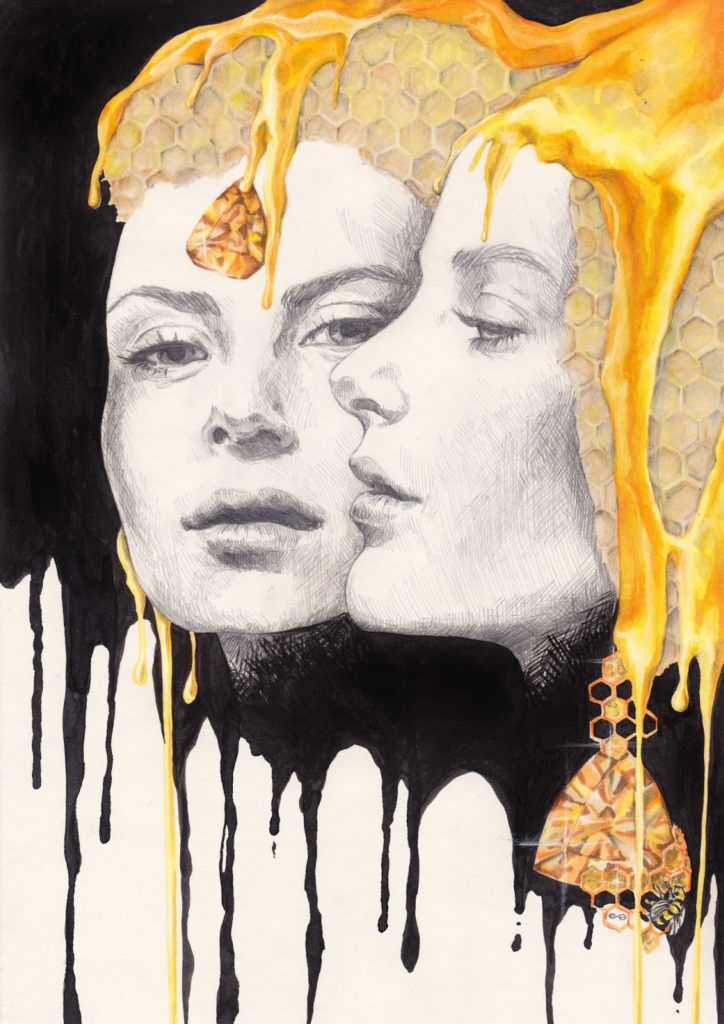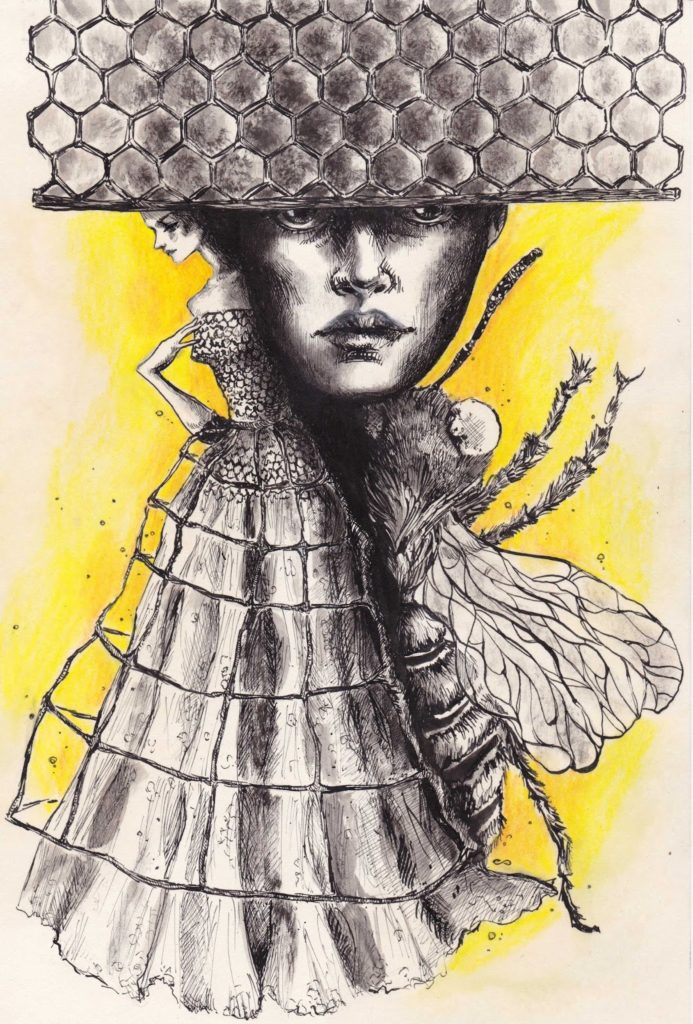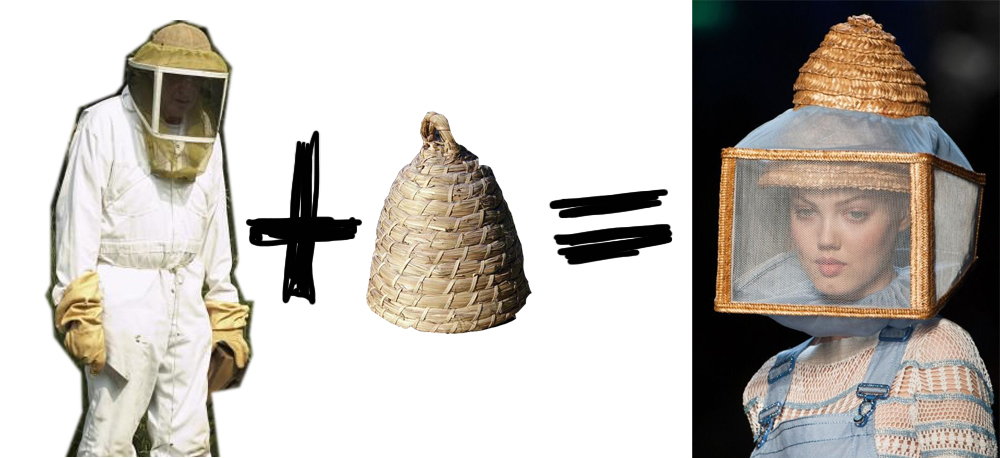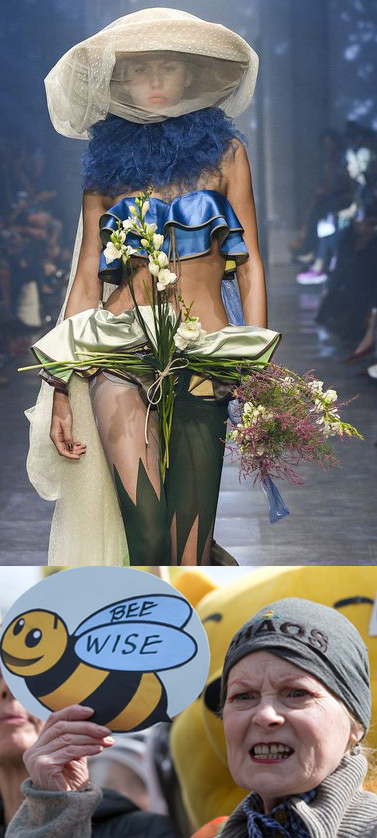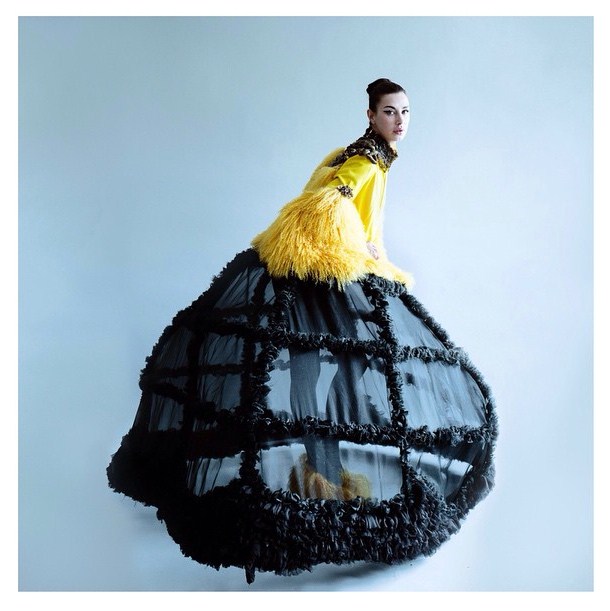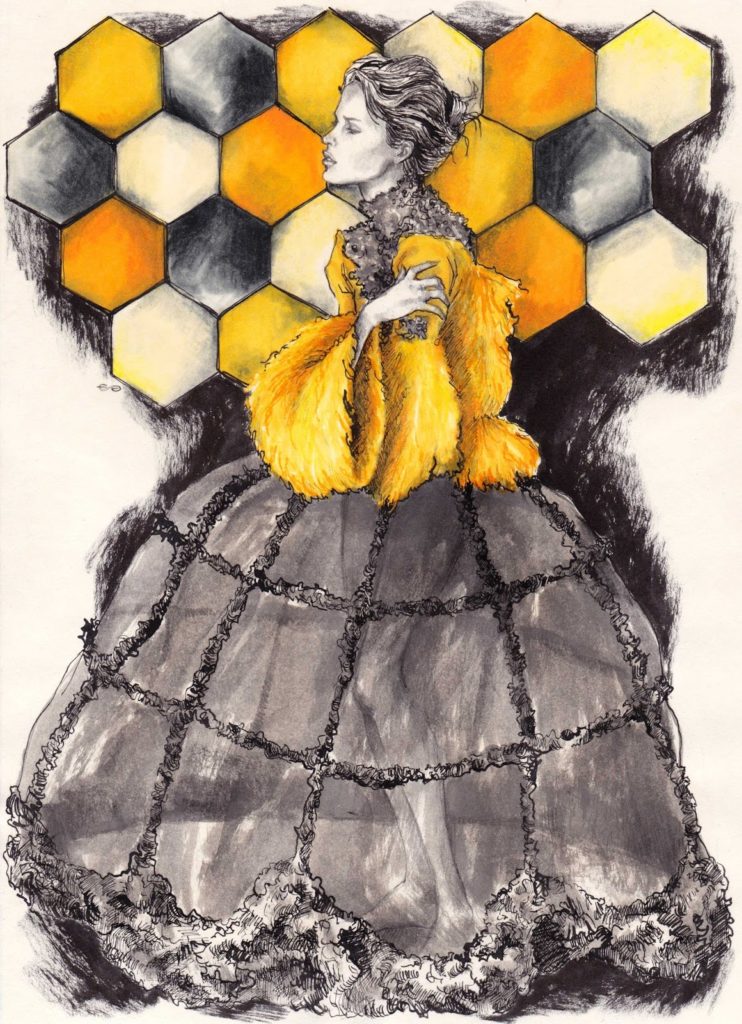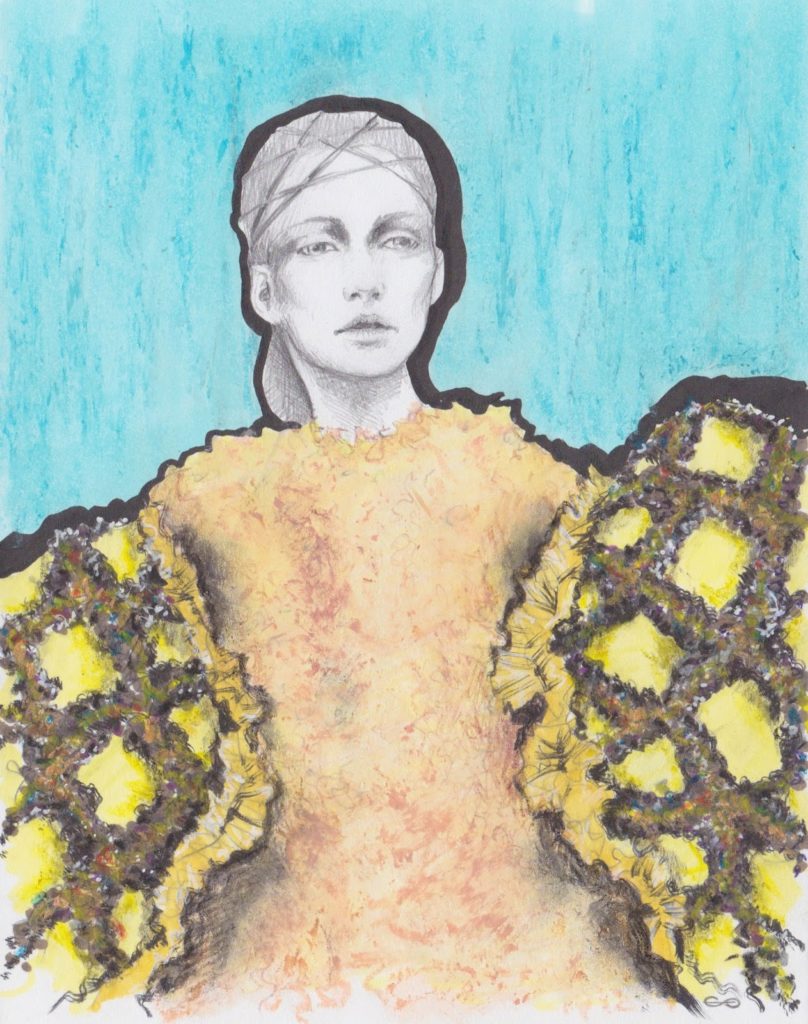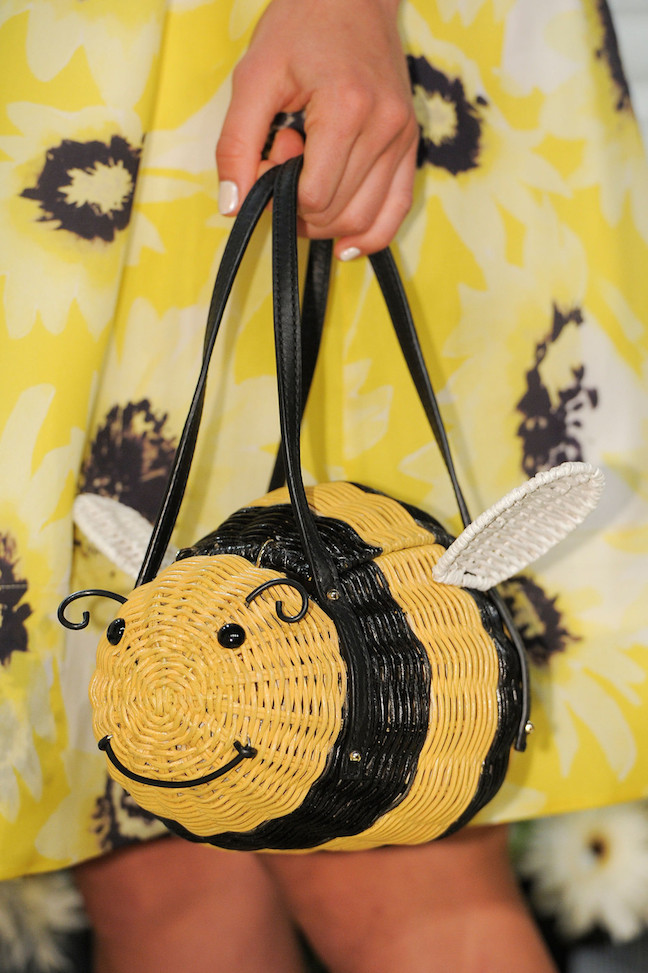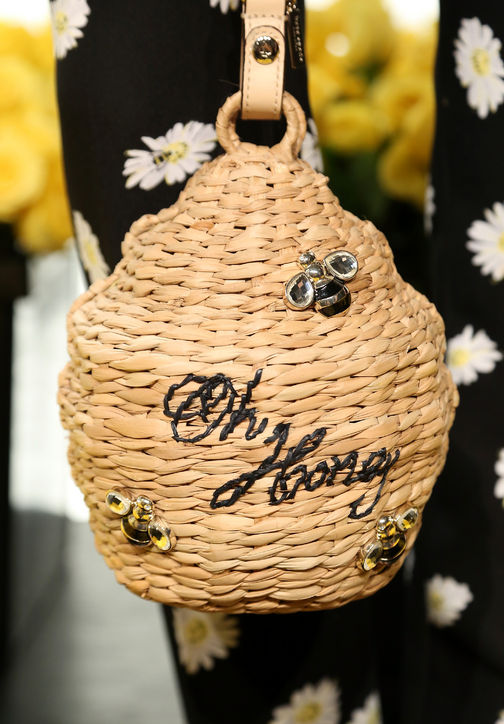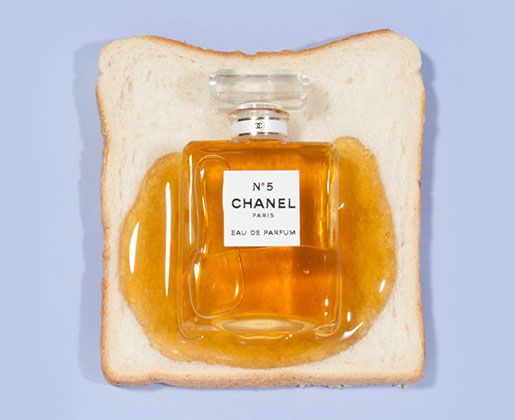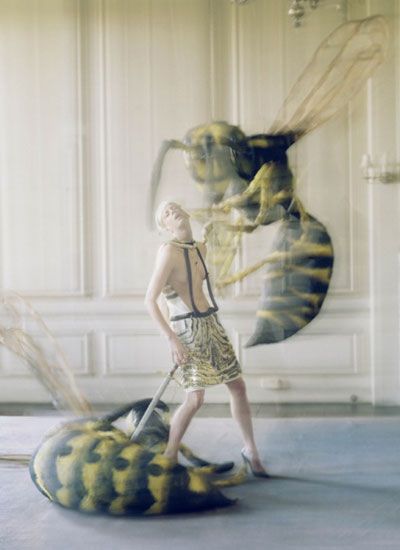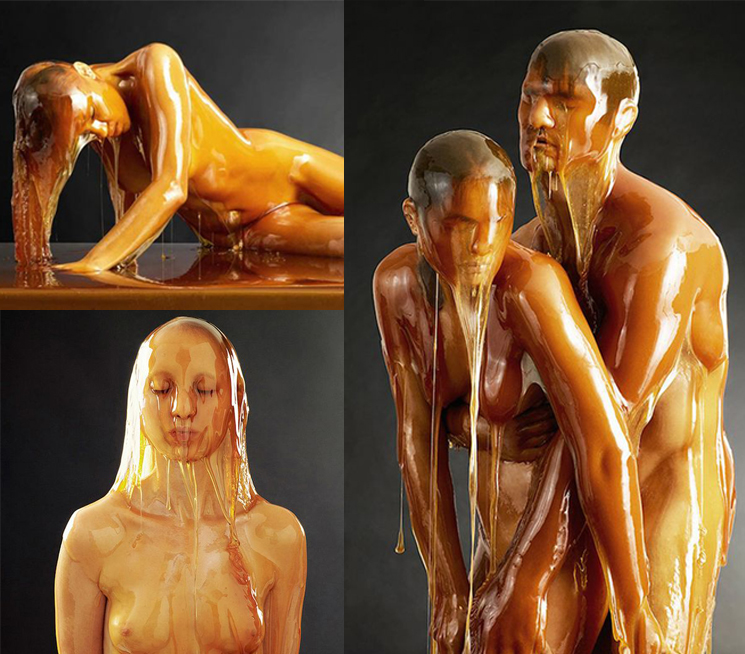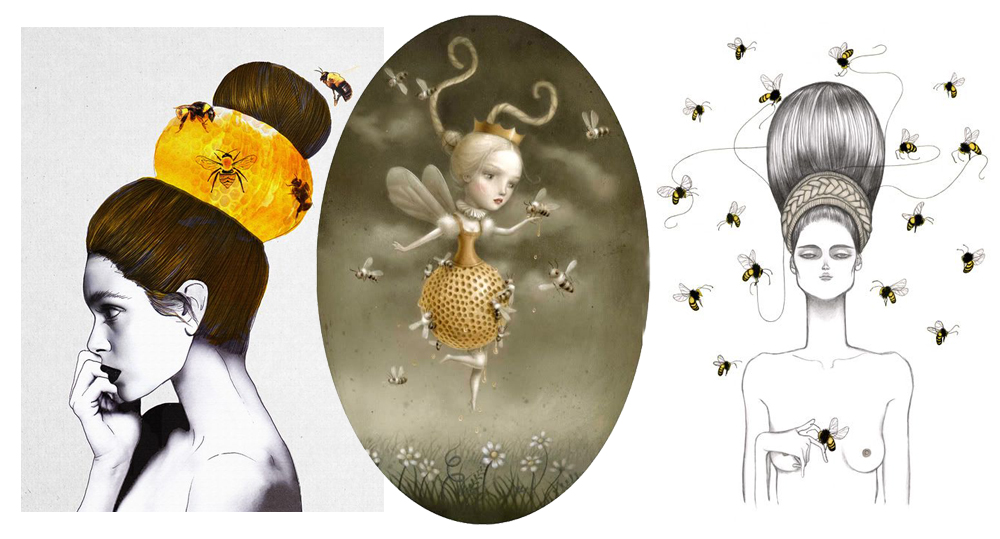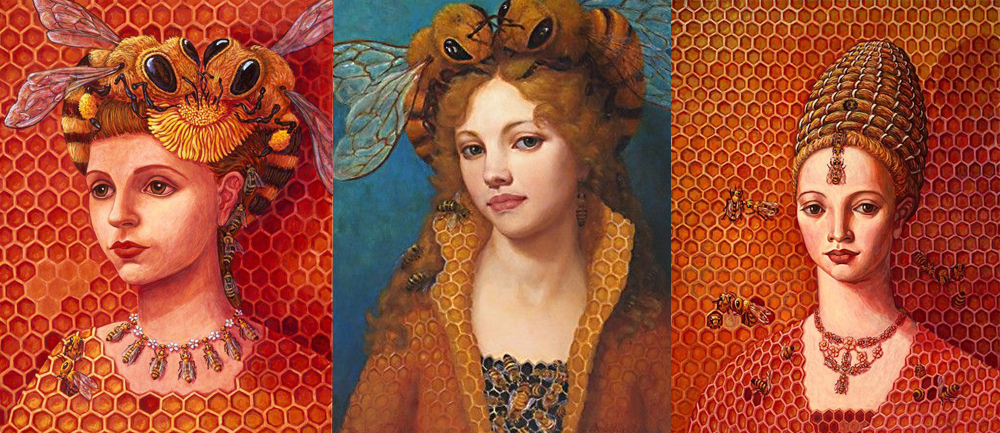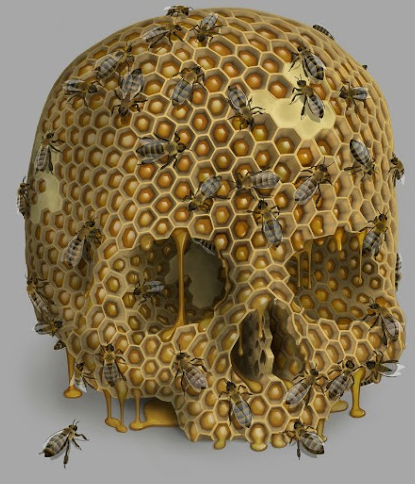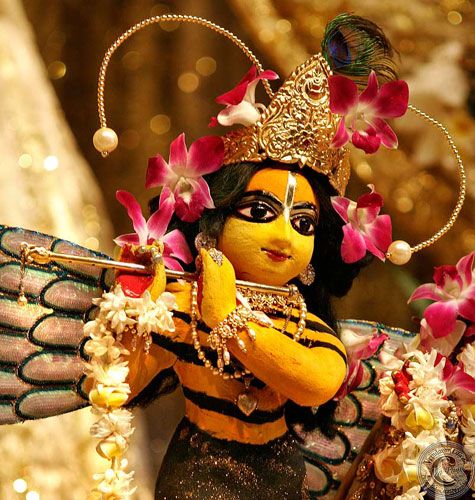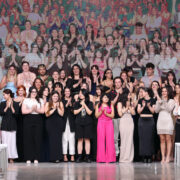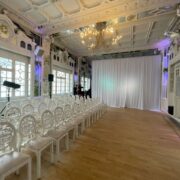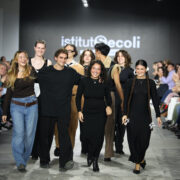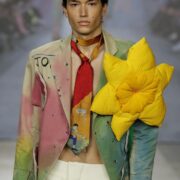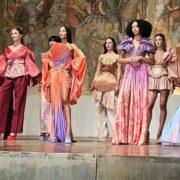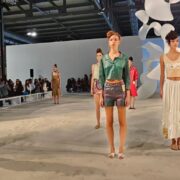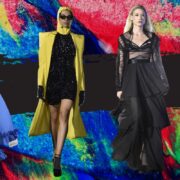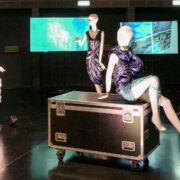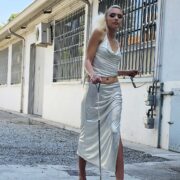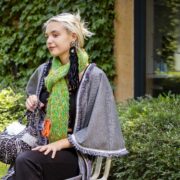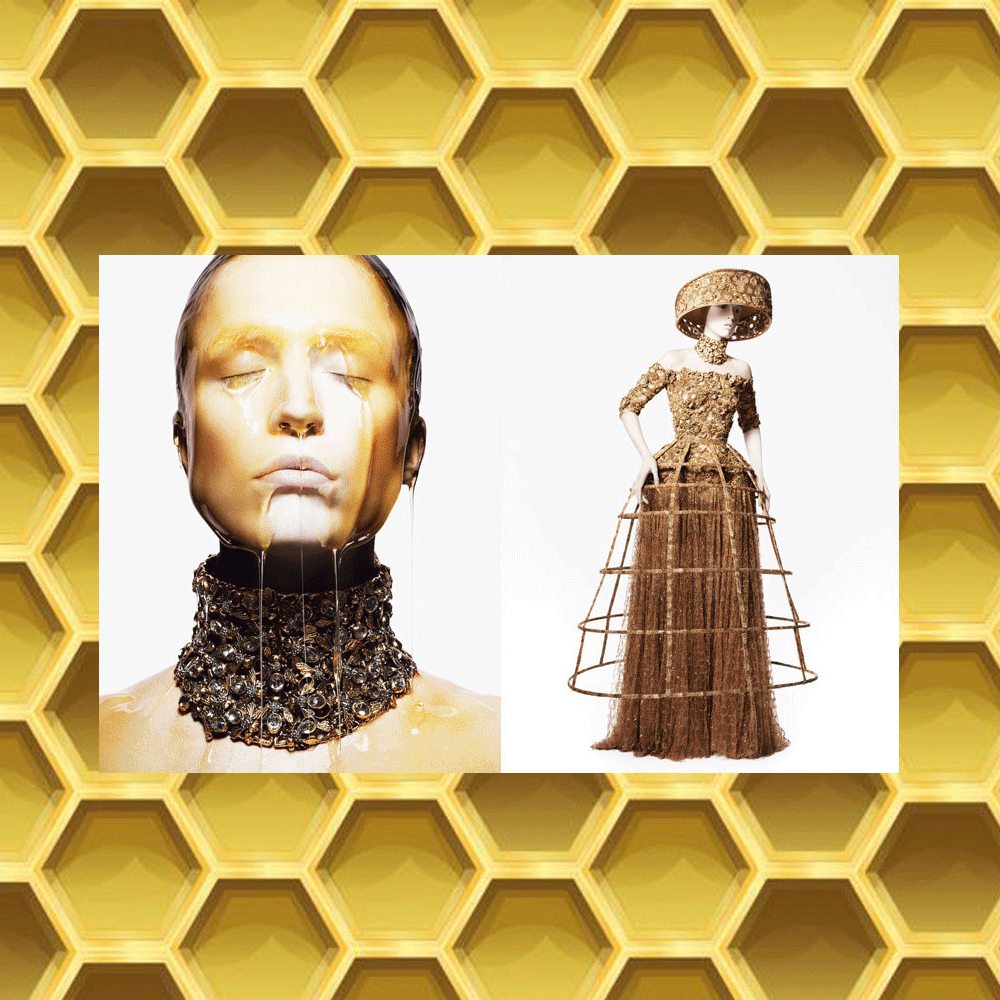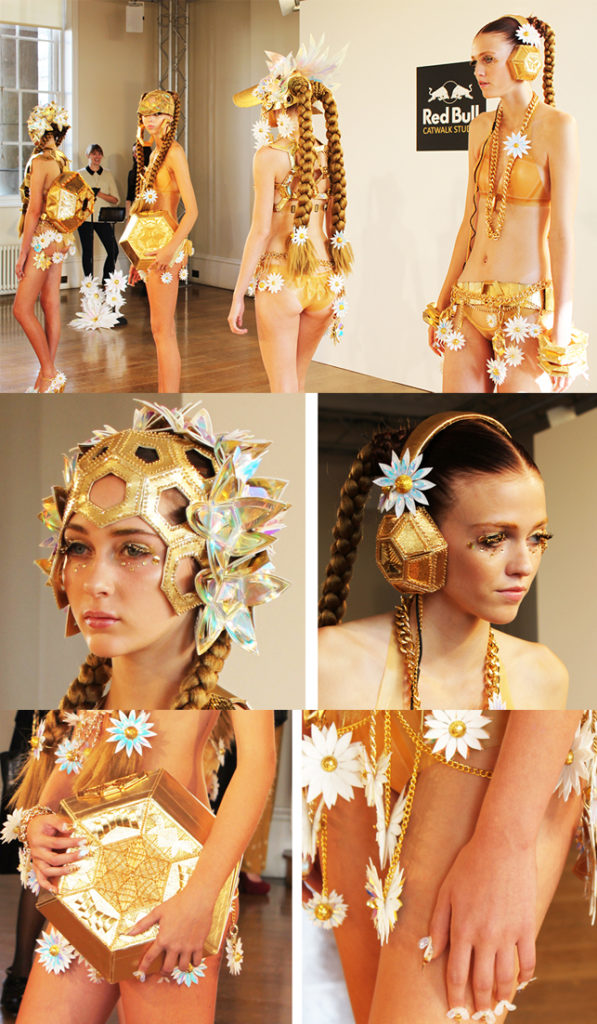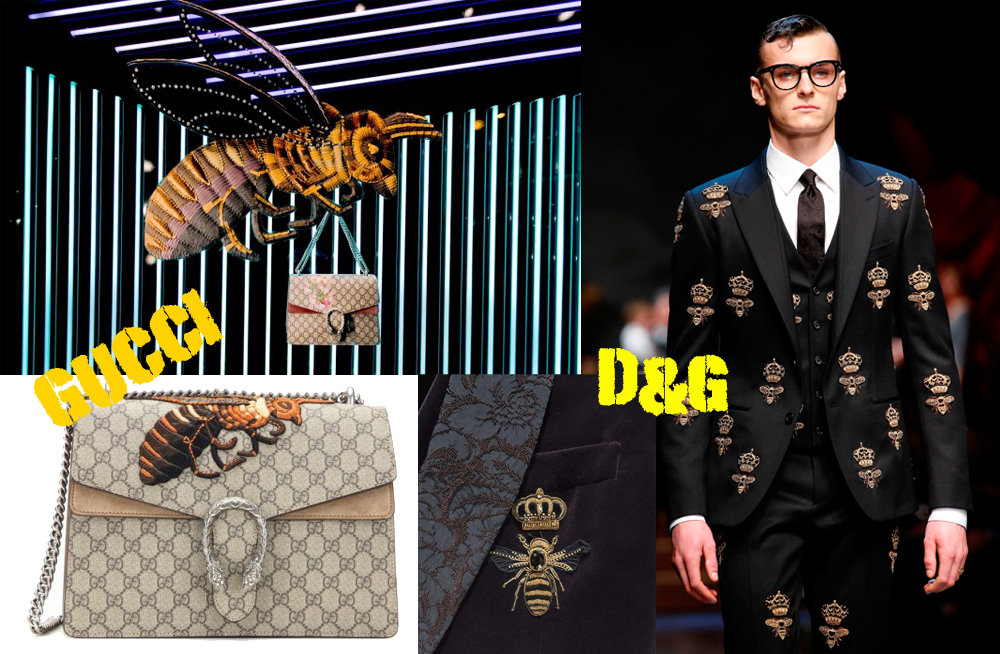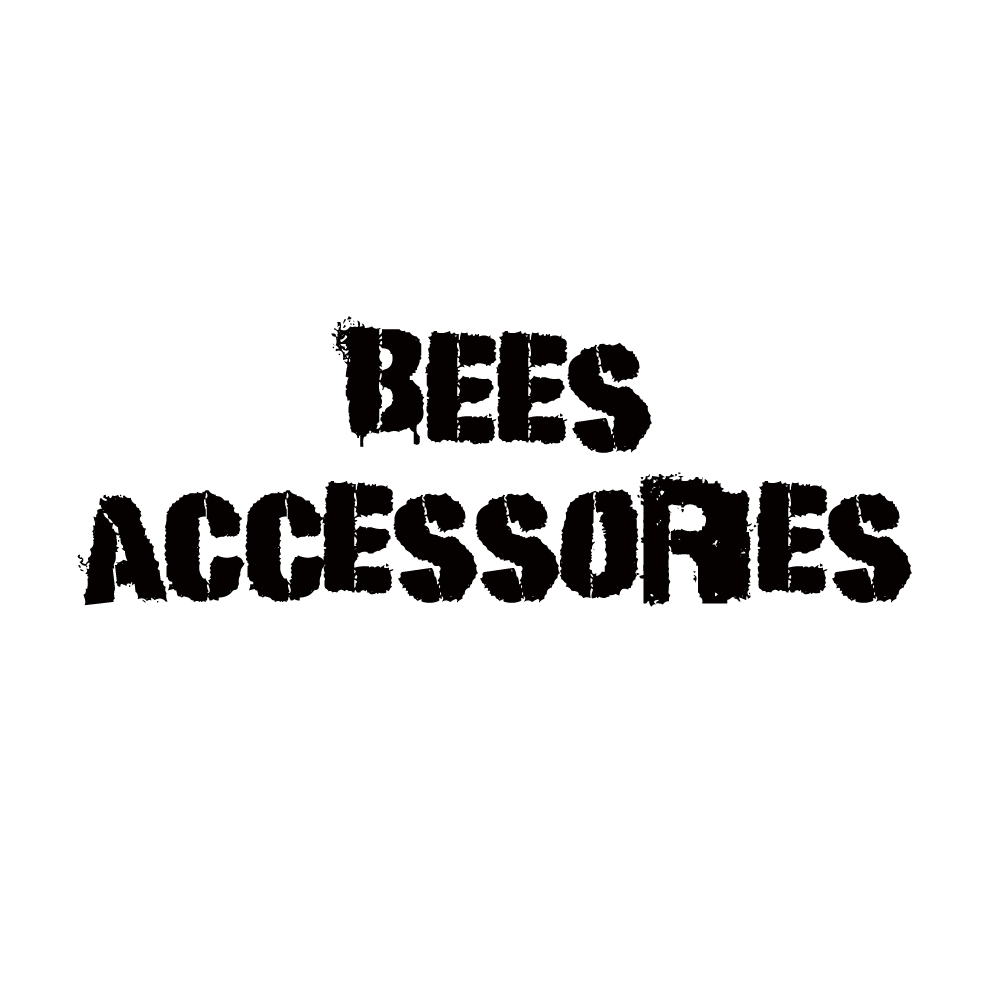Since ancient times the bee was is a widely used symbol. Fashion can not be outdone, and here’s a “swarm“ of insects on clothes and accessories.
(with italian version below)
A powerful and ancestral symbol, present since the most remote periods, the bee was time to time used as a representation of light, chastity, purity, laboriousness, the Sun and the majesty.
Even from ancient Greece draped dresses were held on the shoulders by golden fibulae, earrings and pendants depicted the noble insect.
The crazy world of Fashion cannot miss a so important iconographic element and from the 19th century, “wear like a bee“ gradually assumed a connotation increasingly serious. Initially seen as merely carnival costumes, the yellow-black conquest the couturier’s hearts, dresses lose their wings and the bee becomes inspiration of prints, embroideries, colors.
 |
| Fashion illustration by Elisa Gibaldi |
A matriarchal society ruled by women, representing female generative power of Nature, this is the inspiring theme of Sarah Burton‘s spring/summer 2013 collection for Alexander McQueen. The woman becomes a dominant and sensual Queen Bee, squeezed in rigid corsets, mysteriously hidden to the world by hats–retinas, perpetually surrounded by hexagon and hive symbols, by iconographic honey, yellow and black colors.
 |
| Fashion illustration by Elisa Gibaldi |
 |
| Fred Butler |
Also in 2013, the spring blooms even in the sub-urban bee’s accessories in gold plated designed by Fred Butler and presented at the London Fashion Week: headphones, hats, handbags, bras and chains with pendants strictly hexagonal on a flowering of sweet daisies.
In the winter of 2015-16 at Gucci‘s house, the newly entered designer Alessandro Michele plays with heraldry and a pinch of humor using bee pictures as patches and decorations almost anywhere, from jewelry to handbags, to the male outfits. The same at Dolce & Gabbana, who underlined its royal attribute.
Small beekeepers grow. We are in the spring/summer of 2015, the climate is expected torrid, one swarm of bees is ready to puncture the white skin of the model Lindsey Wixson, but Jean Paul Gaultier,indomitable spirit always witty and ready to irony, metaphorically flying in her protection with the creativity of a farmer dress and a protective hat complete with a straw beehive simulation.
 |
| Vivienne Westwood |
Screaming “SAVE THE BEES“, Vivienne Westwood, as Gaultier, is not immune to the charm of the hive. Already in 2013 we find her with signboard in hand, surrounded by activists in yellow–black, ready to fight the rescue cause of this insect. In 2016 for summer collection the spectacular last outing planned by Andreas Kronthaler is dedicated to a 19th century beekeeper model ready to face a swarm. To protect herself a hat and long veils, to propitiate the little animals, a sincere floral offering set between the folds of the small dress.
 |
| Dior |
 |
| Kate Spade |
 |
| Braccialini |
From the French fashion house Dior, Raf Simons leans metallic insects on tulle and bees become accessories to apply to minimal lines as the only decoration, while the American designer Kate Spade, perhaps mindful of the Braccialini lesson before her, is much more ironic, “cartoon“.
So the bee–accessory duo becomes a fanciful excuse for increasingly precious creations. The American fashion house Judith Leiber offers luxurious versions of handbags in the shape of beehives, entirely covered of crystals, some of which have become true pieces of museum and are even exhibited at the Victoria and Albert Museum in London.
And then flying bees on the wrists of models by Giambattista Valli in what was one of his most successful collections inspired by the flowers, the winter Couture 2012, in which the imagery is perhaps inspired by buzzing bees of René Lalique and his delicate and cultured taste for the natural world.
 |
| Anna Pogossova for Chanel N°5 |
 |
| Tim Walker |
The world in black yellow stripes enchant even the visions of the photographer Tim Walker, who with two huge bee builds a dream speech (or nightmare) in another of his fashion stories for Love Magazine in 2012, while Chanel No. 5 becomes delicious like honey smeared on the bread in lifestyle photography created by Anna Pogossova.
Honey covers the bodies of the models for the photographer Blake Little, and become like animals trapped in dripping amber, not yet solidified, preserved to time.
 |
| Blake Little |
Art also uses the bee simply as a decorative way or as a symbol of something profound. Among the illustrators, Nicoletta Ceccoli is a visionary that carries the bee’s image as a bringer of fragile and disturbing dreams, Jenny Liz Rome is more related to fashion and with her beautiful sketch uses the beehive shape to create an acrobatic hairstyle, while the elongated figures designed by Laura Laine are real queens who watching us imperiously.
 |
| Jenny Liz Rome (left), Nicoletta Ceccoli (center), Laura Laine (right) |
 |
| Lea Bradovich |
Bees are a real obsession for Lea Bradovich who, in her portraits incredibly realistic and surreal at the same time, wants to represent the eternal feminine through direct contact with Nature. The result is an allegorical vision of association between society of the bees and the royal families, with clear references to Renaissance portraiture.
 |
| Aganetha Dyck |
In the case of the Canadian Aganetha Dyck we can easily talk of collaboration by many hands (or should I say hands/paws): her works are random and unpredictable results of the union of small porcelain figurines and laborious construction of wax honeycomb that insinuates itself in the folds and crevices of objects chosen by the artist.
In conclusion I leave you with a thought. The souls of honest and calm person will be reborn in the form of bees, so said Plato in his “Doctrine of Transmigration of Souls“. Virgil celebrated the spontaneous generation of life through the birth of the bees from the belly of a sacrificed ox. Or perhaps they are messengers that send our words from Earth to Heaven, towards the Gods?
ITALIAN VERSION
La Bella e l’Ape
Fin dai
tempi più remoti l’ape è stata un simbolo ampiamente utilizzato. La moda
non può essere da meno, ed ecco uno “sciamare” di insetti su abiti e
accessori.
Un simbolo potente e ancestrale, presente fin dai tempi più remoti,
l’ape è stata di volta in volta usata come rappresentazione della luce, della castità, della purezza, della laboriosità, del Sole e della regalità. Già dall’antica Grecia gli abiti drappeggiati venivano trattenuti sulle spalle da fibule in oro, orecchini e pendenti raffiguravano il nobile insetto.
Il pazzo universo della Moda non poteva farsi sfuggire un elemento iconografico di tale portata e a partire dall’Ottocento, “vestirsi da ape”
assumeva pian piano un connotato sempre più serio. Inizialmente visto
come un mero costume carnevalesco, il giallo-nero conquista i cuori dei
couturier, gli abiti perdono le loro ali e l’ape diventa ispirazione di
stampe, ricami, colori.
Una società matriarcale governata da donne, che rappresenta la potenza
generatrice e femminile della Natura, questo è il motivo ispirante della
collezione primavera/estate 2013 di Sarah Burton per Alexander McQueen. La donna diventa un’Ape Regina
dominante e sensuale, strizzata nei corsetti rigidi, misteriosamente
nascosta al mondo da cappelli-retine, perennemente circondata dai
simboli dell’esagono e dell’alveare, dai colori iconografici miele,
giallo e nero.
Sempre nel 2013 la primavera sboccia anche negli accessori da ape sub-urbana in placcatissimo oro disegnati da Fred Butler e presentati alla London Fashion Week: cuffiette, cappellini, borsette, reggiseni e catene con pendagli rigorosamente esagonali uno sbocciare di tenere margherite.
Nell’inverno 2015-16 in casa Gucci, il neo-entrato designer Alessandro Michele gioca
con l’araldica e un pizzico di senso dell’umorismo utilizzando le
immagini delle api come patch e decori praticamente ovunque, dai
gioielli alle borse, fino alle mise da uomo. Idem Dolce&Gabbana, che ne sottolineano l’attributo regale.
Piccole apicoltrici crescono. Siamo nella primavera estate del 2015, il
clima si prevede torrido, uno sciamare di api pronte a pungere la
candida pelle della modella Lindsey Wixson, ma Jean Paul Gaultier,
spirito indomito sempre arguto e pronto all’ironia, vola
metaforicamente in sua protezione con la creatività di un
abito-salopette e di un cappello protettivo con tanto di simulazione di
alveare in paglia.
All’urlo di “SAVE THE BEES“, Vivienne Westwood,
come Gaultier, non è immune al fascino dell’alveare. Già nel 2013 la
troviamo con cartello in mano, circondata da attiviste in giallo-nero,
pronta a combattere la causa del salvataggio di questo insetto. Nel 2016
per la collezione estiva l’ultima spettacolare uscita prevista da Andreas Kronthaler
è dedicata ad una modella in tenuta da apicoltrice ottocentesca pronta
ad affrontare uno sciame. Per proteggersi un cappello e lunghi veli, per
propiziarsi gli animaletti, una sincera offerta floreale incastonata
tra le pieghe dell’esiguo abitino.
Stessa stagione, stessa atmosfera. Ricche di polline e regalità sono le donne del giovanissimo e talentuoso designer portoghese David Ferreira.
Incedono solenni ammantate di piume e pelliccia, sontuose nelle forme
assolutamente ardite e nella scelta del duo coloristico nero e giallo
sole (qui una sfumatura più calda che altrove). A lui ho dedicato due
illustrazioni.
Dalla maison francese Dior, Raf Simons
appoggia metallici insetti sul tulle e le api diventano accessori da
applicare alle linee minimali come unica decorazione, mentre la designer
americana Kate Spade, forse memore della lezione di Braccialini prima di lei, è decisamente più ironica e “fumettosa“.
Da qui il binomio ape-accessorio diventa un fantasioso pretesto per creazioni sempre più preziose. La casa di moda americana Judith Leiber
propone lussuose versioni di borsette a forma di alveari, ricoperte
interamente di cristalli, alcune delle quali sono diventate vere e
proprie opere da museo e vengono persino esposte al Victoria and Albert Museum di Londra.
E poi api volanti sui polsi delle modelle di Giambattista Valli
in quella che è stata una delle sue più riuscite collezioni ispirate ai
fiori, la Couture dell’inverno 2012, il cui immaginario è forse
ispirato alle api ronzanti di René Lalique e al suo gusto delicato e colto per il mondo naturale.
Il mondo a strisce giallo nere incanta anche le visioni del fotografo Tim Walker, che con due enormi api costruisce un discorso da sogno (o da incubo) in un altro dei suoi racconti di moda per la rivista Love Magazine nel 2012, mentre Chanel n°5 diventa goloso come il miele spalmato sul pane nella fotografia di lifestyle creata da Anna Pogossova.
Il miele ricopre i corpi dei modelli per il fotografo Blake Little, che diventano come animali intrappolati nell’ambra colante, non ancora solidificata, preservati dal tempo.
Anche l’arte utilizza l’ape semplicemente come mezzo decorativo o come simbolo di qualcosa di profondo. Tra le illustratrici, Nicoletta Ceccoli è una visionaria che veicola l’immagine dell’ape come portatrice di sogni fragili e inquietanti, Jenny Liz Rome
è più legata alla moda e con il suo bellissimo tratto sfrutta la forma
dell’alveare per creare una funambolica acconciatura, mentre le figure
allungate disegnate da Laura Laine sono vere e proprie regine che ci osservano imperiose.
Le api sono una vera e propria ossessione per Lea Bradovich
che, nei suoi ritratti incredibilmente realistici e allo stesso tempo
surreali, vuole rappresentare l’eterno femminino attraverso il contatto
diretto con la Natura. Il risultato è una visione allegorica di
associazione tra la società delle api e le famiglie reali, con chiari
richiami alla ritrattistica rinascimentale.
Nel caso della canadese Aganetha Dyck
si può tranquillamente parlare di collaborazione a più mani (o forse
dovrei dire mani/zampe): le sue opere sono il risultato casuale e
imprevedibile dell’unione tra piccole statuine di porcellana e la
laboriosa costruzione di cera dell’alveare che si insinua tra le pieghe e
gli anfratti degli oggetti scelti dall’artista.
Per concludere vi lascio con un pensiero. Le anime delle persone oneste
e placate rinasceranno sotto forma di api, così affermava Platone nella sua “Dottrina della Trasmigrazione delle Anime”. Virgilio celebrava la generazione spontanea della vita attraverso la nascita delle api dal ventre di un bue sacrificato. O forse son messaggere che inviano le nostre parole dalla Terra al Cielo, verso gli Dei?
